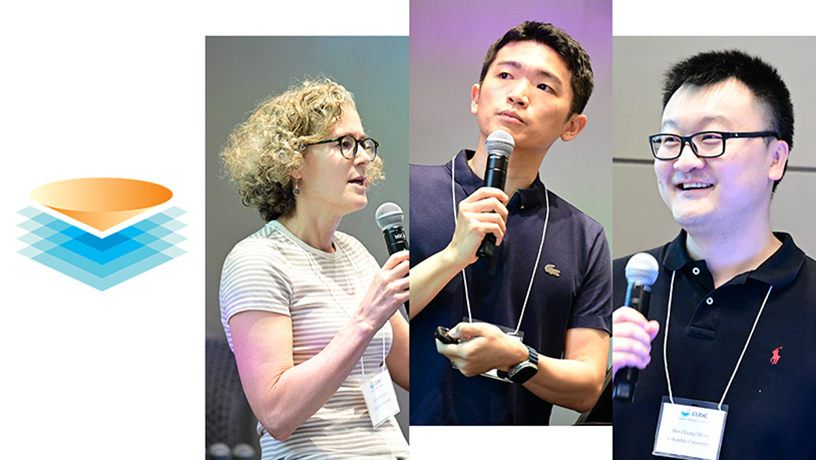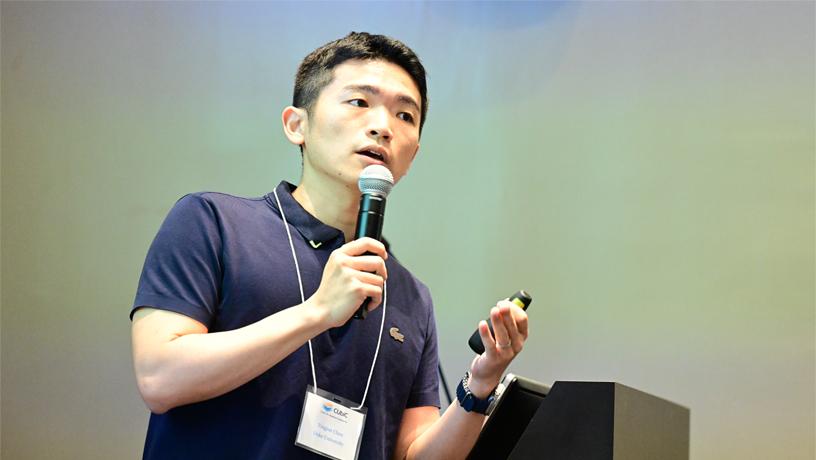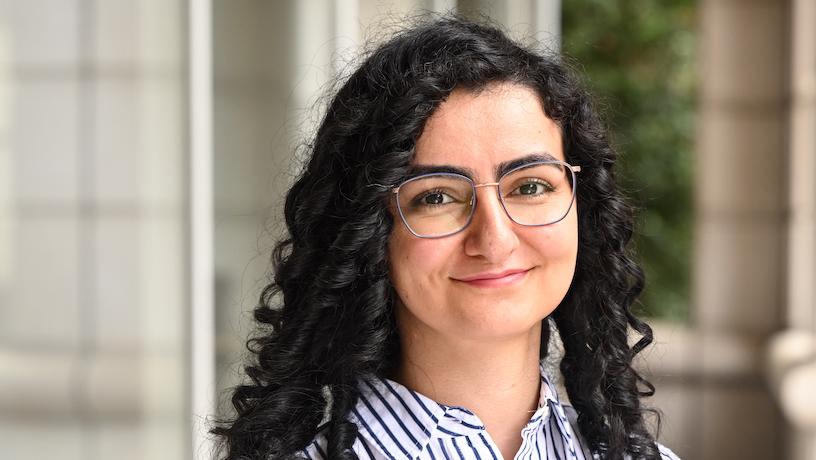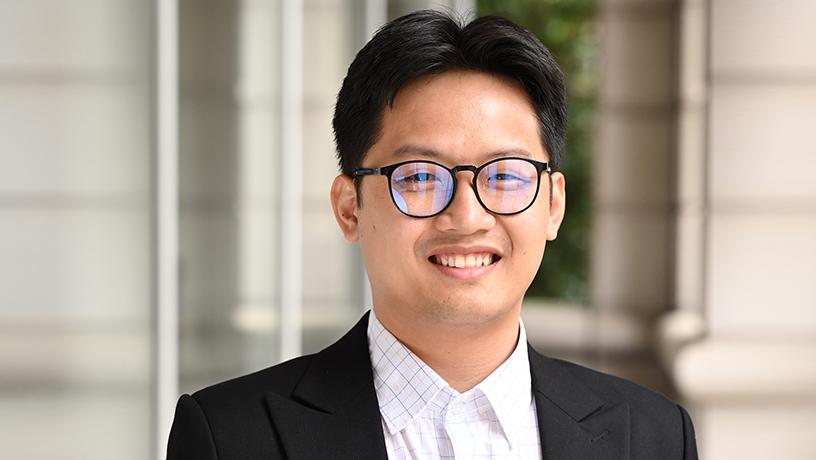Meeting New Data Demands at the Edge and in the Cloud
At its second annual review, the Center for Ubiquitous Connectivity (CUbiC) emphasized advancements in energy efficiency, disruptive innovation, and its support for the next generation of the semiconductor workforce.

CUbiC, a research center led by Columbia Engineering, held its annual symposium in June, hosting presentations, poster sessions, and demos across three research themes: connectivity networks and systems, wireline and lightwave interconnects, and wireless circuits and technology. Presenters, left to right, Keren Bergman, Tingjun Chen, and Alex Meng. Credit: Chris Taggart
Since its inaugural annual review last year, a primary research mission at the Center for Ubiquitous Connectivity (CUbiC) has become a topic of national conversation.
“One of the biggest challenges on the front page of the news is the energy consumption associated with communication and workloads of AI data centers,” said CUbiC Director Keren Bergman, Charles Batchelor Professor of Electrical Engineering at Columbia Engineering.
In addition to consuming tremendous amounts of energy, the ever-growing number of AI systems being developed and deployed are causing data bottlenecks that prevent seamless connectivity. These traffic jams are occuring within data centers and at the edge, where the number of sensors and small devices that collect and process data is expanding rapidly.
“These are systems-level challenges, and CUbiC is a systems-level center,” Bergman said. “We have a very integrated vision for how we’re addressing these challenges.”
On June 27 and 28, faculty, students, researchers, industry experts, and government officials convened in Morningside Heights to discuss CUbiC’s research, its funders’ priorities, and to celebrate advancements in technology and outreach. In a series of presentations, poster sessions, demonstrations, and discussions, CUbiC’s members and students offered updates from across its three research themes: connectivity networks and systems, wireline and lightwave interconnects, and wireless circuits and technology.
CUbiC, a research center led by Columbia Engineering, launched in January 2023 with $35 million in grant funding by the Joint University Microelectronics Program 2.0 (JUMP 2.0). The center is part of an initiative to support high-risk, high-payoff research that addresses existing and emerging challenges in information and communication technologies, co-sponsored by the Semiconductor Research Corporation (SRC), the Defense Advanced Research Projects Agency (DARPA), the commercial semiconductor industry, and the defense industrial base.
In remarks at the first session, Columbia Engineering Dean Shih-Fu Chang emphasized the School’s historic contributions and commitment to communications technology, computing, and photonics. “Semiconductors, photonics, wireless ubiquitous computing, and connectivity are among the most important strategic areas for Columbia Engineering and for the whole University,” he said.
With 24 PIs, more than 114 PhD students, and 17 undergraduates, CUbiC’s footprint stretches across 15 universities. The center’s new NSF REU program will increase its number of undergraduate researchers and advance its workforce development and broadening participation missions to include students from even more institutions.
Young Investigators Spotlight

Tingjun Chen, during his presentation at the CUbiC symposium
Tingjun Chen MS‘15, PhD’20 began his research career in the department of electrical engineering through the COSMOS project, under Professor Gil Zussman. Now an assistant professor of electrical and computer engineering at Duke University and a co-PI at CUbiC, Chen was invited to speak at the CUbiC Annual Review on connectivity networks and systems. Chen is also a co-founder of WiLO Networks Inc., which specializes in low-power sensor hardware and systems.
Chen's research, titled "Cross-layer Resource Allocation for Terabit VRANs" (CLaRA), focuses on developing cross-layer resource allocation and scheduling algorithms to enhance wireless connectivity from mmWave access to backhaul networks. The project aims to create efficient and high-performance wireless communication systems that can support the increasing demand for bandwidth in future networks. Chen's objectives include developing cross-layered resource allocation and scheduling algorithms, maintaining virtual links to users, and managing resource allocation for access, front-haul/backhaul links, and edge data centers. He creates algorithms that work together to optimize different types of wireless and computing resources. These algorithms ensure reliable performance and quick results, helping to manage everything from wireless signals to computer processors efficiently.
Reflecting on his journey in science, Chen advises aspiring researchers in this field, "Don't be afraid of difficult engineering problems and challenges or crossing the boundary between hardware and software. Spend time building comprehensive systems and learn every single detail. This approach allows you to develop unique capabilities and become both a qualified researcher and engineer."

Sanaz Sadeghi
Sanaz Sadeghi, a prominent CUbiC student researcher, is working towards her PhD in electrical and computer engineering with the Molnar Group at Cornell University. Holding BSc and MSc. degrees from Sharif University of Technology, Sadeghi focuses on cutting-edge research in RF communication systems. Her poster, "Synthetic Diversity: A Novel Architecture for Artifact Suppression and Simultaneous Multiband Down-conversion in Widely-Tunable Receivers," highlights her innovative approach to interference mitigation.
Reflecting on her experience as a CUbiC student researcher, she said, “CUbiC provides the opportunity to be in close contact and have collaboration with experts in my field. It allows me to receive constructive feedback and align my research with industry needs. This platform is invaluable for both personal and professional growth."
She highlighted the need to develop receivers that can handle interference and radios that can adapt to different signals. This research is crucial for making the most of the limited frequency spectrum and meeting the increasing demand for wireless connections among smart devices.
Sadeghi’s research addresses the challenges posed by out-of-band (OOB) interferers, which generate in-band artifacts (IBAs) such as reciprocal mixing, intermodulation, and harmonic down-conversion. Her work on synthetic diversity involves a receiver architecture that suppresses these IBAs using a blind algorithm that does not require knowledge of the interferer. This allows for the simultaneous suppression of multiple artifacts and signal recovery, enhancing the efficiency of widely-tunable receivers.

Phong Nguyen
Phong Nguyen, another dedicated CUbiC student researcher and a member of Columbia’s CoSMIC Laboratory is currently pursuing his PhD in electrical engineering under the guidance of Professor Harish Krishnaswamy. Nguyen's academic journey began with his BS and MS degrees from Case Western Reserve University, where he was recognized with the ISSACS fellowship for his remarkable work on a ground penetrating radar (GPR) system for urban infrastructure surveying. Nguyen's research interests lie in the design and optimization of RF/mmave, analog, and mixed-signal integrated circuits, focusing on their integration into communication systems.
"I want to achieve something that can impact society on a large scale while aligning with my interest in physics and electrical engineering. That's why I chose to pursue a PhD in RF and millimeter-wave IC designs,” Nguyen said. “This field holds great potential to help many people through advancements in communication technology."
When asked about the most exciting industrial trends, CUbiC student researchers Nguyen and Sadeghi shared their perspectives on the future of wireless technology. Nguyen highlighted the challenges and opportunities associated with higher frequency bands in 5G and 6G.
"Right now, there’s no application that can commercially utilize the ultrawide bandwidth that 5G and 6G can provide, but I imagine future applications will involve wireless communication between AI chips or robots,” Nguyen explained. “Applications like AR and VR, or remote surgeries, will also require high bandwidth. This is why a center like CUbiC is important because it allows experts in different fields to collaborate and solve problems from both technical and application perspectives."
Sadeghi expressed her enthusiasm for the potential of cooperative spectrum sharing. "I’m excited to see the ideas of cooperative spectrum sharing being implemented in real life. There’s an opportunity to optimize protocols and system levels to make better use of free spectrum bands. This could allow more devices to connect seamlessly and non-disruptively," she said.
Their insights underscore the importance of innovation and collaboration in advancing communication technologies, paving the way for future developments in the field.
